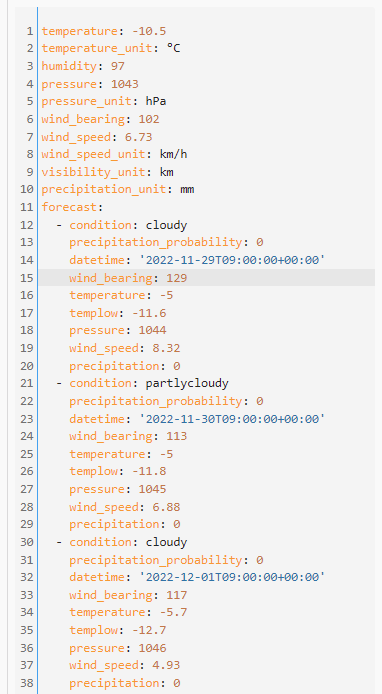I have been teaching myself to use JSONata in Node-RED in preference to using functions and JavaScript code. I pull both the import and export Octopus UK agile tariff prices once per day, and then turn this into a single tariff array which I store in Node-RED context for use as required.
As this thread is about the flex-table-card, I will just post the part of my flow that gets the agile import / export, turns these into one array, and stores it in Node-RED context. This array can be displayed in a flex-table-card as discussed earlier.
The part that you probably want is just the top sequence. Inject trigger to fire once per day, two API calls to Octopus to get the tariffs, change node to move msg.results to msg.payload and set the topic to import/export, a join node that puts both result objects into one object, and a bit of JSONata to get this into one array.
The saved array gets read back from context every 30 minutes to pull the current and next prices, and I also process the array into the best 15 (lowest/highest) import/export periods and combine consecutive groups into longer periods. This gets pushed to HA, where I can display the data.
I use the flex-table-card to show tariff prices as well as the best period groups.
Here is the part of the flow that gets both import/export into one array. Note that the API call is set for my region (the South West) and that I am using the most recent agile tariffs that I can find. Octopus are currently not offering agile tariffs, and as I am not using an agile tariff myself I had to hunt around to find the ‘current’ ones. I am pulling 48 hours worth of data (96 half-hour data points) so that my chart always shows at least today up to 23:00, and after 16:00 it will show both today and tomorrow.
[{"id":"db6ebccc4bb88b8d","type":"http request","z":"2dd6b0b4a5f86125","g":"e42010beae8f7fa5","name":"Octopus Export","method":"GET","ret":"obj","paytoqs":"ignore","url":"https://api.octopus.energy/v1/products/AGILE-OUTGOING-19-05-13/electricity-tariffs/E-1R-AGILE-OUTGOING-19-05-13-L/standard-unit-rates/?page_size=96","tls":"","persist":false,"proxy":"","insecureHTTPParser":false,"authType":"","senderr":false,"headers":[],"x":320,"y":1960,"wires":[["65094b21c3938d73"]]},{"id":"63bba87f93e0eaae","type":"http request","z":"2dd6b0b4a5f86125","g":"e42010beae8f7fa5","name":"Octopus Import","method":"GET","ret":"obj","paytoqs":"ignore","url":"https://api.octopus.energy/v1/products/AGILE-22-08-31/electricity-tariffs/E-1R-AGILE-22-08-31-L/standard-unit-rates/?page_size=96","tls":"","persist":false,"proxy":"","insecureHTTPParser":false,"authType":"","senderr":false,"headers":[],"x":320,"y":1920,"wires":[["22fdc0bfd7bdd329"]]},{"id":"65094b21c3938d73","type":"change","z":"2dd6b0b4a5f86125","g":"e42010beae8f7fa5","name":"Results","rules":[{"t":"set","p":"payload","pt":"msg","to":"payload.results","tot":"msg"},{"t":"set","p":"topic","pt":"msg","to":"export","tot":"str"}],"action":"","property":"","from":"","to":"","reg":false,"x":480,"y":1960,"wires":[["3c0e6412766b7286"]]},{"id":"22fdc0bfd7bdd329","type":"change","z":"2dd6b0b4a5f86125","g":"e42010beae8f7fa5","name":"Results","rules":[{"t":"set","p":"payload","pt":"msg","to":"payload.results","tot":"msg"},{"t":"set","p":"topic","pt":"msg","to":"import","tot":"str"}],"action":"","property":"","from":"","to":"","reg":false,"x":480,"y":1920,"wires":[["3c0e6412766b7286"]]},{"id":"3c0e6412766b7286","type":"join","z":"2dd6b0b4a5f86125","g":"e42010beae8f7fa5","name":"Combine","mode":"custom","build":"object","property":"payload","propertyType":"msg","key":"topic","joiner":"\\n","joinerType":"str","accumulate":false,"timeout":"","count":"2","reduceRight":false,"reduceExp":"","reduceInit":"","reduceInitType":"num","reduceFixup":"","x":640,"y":1920,"wires":[["416e22ecfcbf5616"]]},{"id":"0ba1d9b378092267","type":"inject","z":"2dd6b0b4a5f86125","g":"e42010beae8f7fa5","name":"@ 16:05","props":[{"p":"payload"}],"repeat":"","crontab":"05 16 * * *","once":true,"onceDelay":"2","topic":"","payload":"","payloadType":"date","x":140,"y":1920,"wires":[["db6ebccc4bb88b8d","63bba87f93e0eaae"]]},{"id":"416e22ecfcbf5616","type":"change","z":"2dd6b0b4a5f86125","g":"e42010beae8f7fa5","name":"Build & Save Tariff Array","rules":[{"t":"set","p":"payload","pt":"msg","to":"payload.import#$i.{\t \"from\": valid_from,\t \"upto\": valid_to,\t \"date\": $substring(valid_from,0,10),\t \"timefrom\": $substring(valid_from,11,5),\t \"timeupto\": $substring(valid_to,11,5),\t \"import\": value_inc_vat,\t \"export\": %.export[$i].value_inc_vat\t}^(from)","tot":"jsonata"},{"t":"set","p":"OctAgileTariff","pt":"flow","to":"payload","tot":"msg","dc":true}],"action":"","property":"","from":"","to":"","reg":false,"x":830,"y":1920,"wires":[["56dd710454ea2e25"]]}]
I hope this is of some use.




 )?
)?







